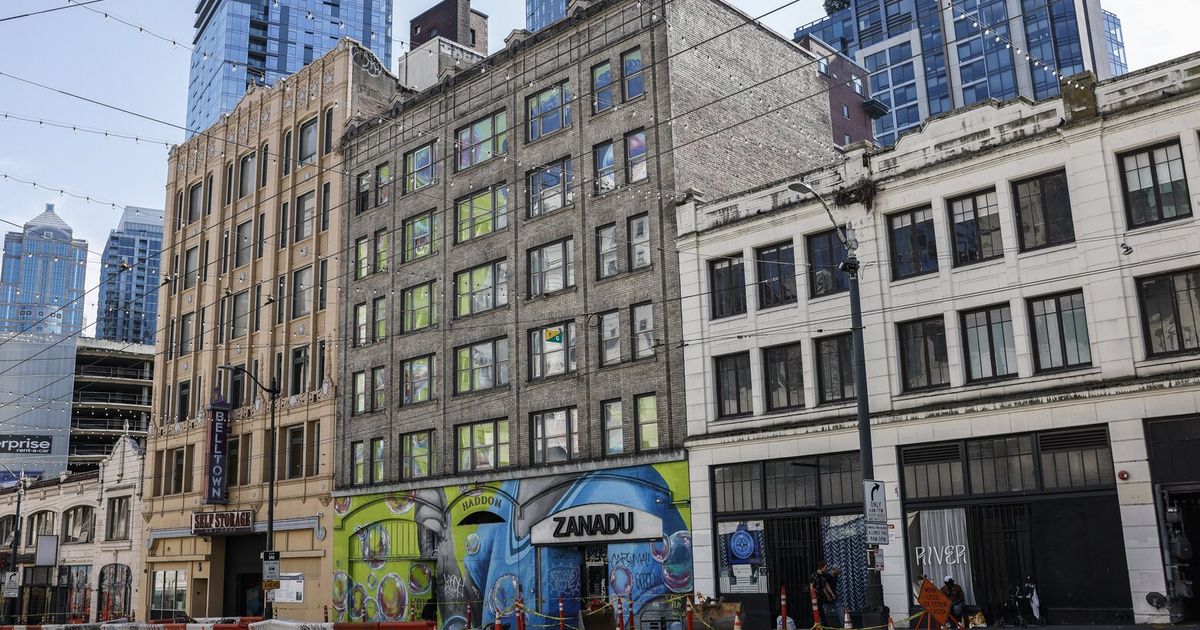Against all odds, Barbara Millicent Roberts bought her first home in 1962. Women were denied mortgage applications because of their sex or marital status at the time, but that didn’t stop her.
The house was modest: a yellow-walled ranch home made of cardboard. For Roberts — better known as Barbie — it was a dream, and it soon became a national craze. Today, according to Mattel, the toymaker behind the iconic doll, a new Barbie Dreamhouse is sold every two minutes.
Barbie’s body, careers, lifestyle and house — a hot pink monument of decadence and desire, now equipped with a swimming pool, slide and elevator — have all been qualities designed for children (and adults) to crave for themselves. Barbie has been the platonic ideal of what a young woman could and should be.
“Every little girl needed a doll through which to project herself into her dream of her future,” Ruth Handler, the inventor of Barbie, told The New York Times in 1977. She named the doll after her daughter. (Ken was named after Handler’s son.)
Even the dollhouse itself is a status symbol among owners: Its retail value is $199.99, and one must have a home large enough to accommodate the nearly 4-foot-tall structure.
To bring the doll’s world to cinematic life for the buzzy Hollywood movie “Barbie,” four life-size Dreamhouses were erected at studios in Britain, leading to a shortage in a supply of pink paint.
From the beginning, much of Barbie’s existence — her unrealistic physical proportions, the lack of racially diverse dolls, the toy’s reinforcing of gender roles — has been debated in jest and in seriousness.
But her home, which has not been as publicly parsed or praised as the doll, has been a mirror for the various social, political and economic changes the country was experiencing. It has followed housing patterns and trends, from chic, compact urban living to suburban sprawl to pure excess. At times, it has been out of step, ignoring the country’s ills. (Barbie has never been broke; she has never lost her house to foreclosure.)
The house has served as a subliminal, maybe even subversive, blueprint for children, especially girls. Barbie’s Dreamhouse was all her own. Ken was not on the deed.
Barbie’s bachelorette pad
Financial institutions often turned down mortgage applications for women without male co-signers when Mattel debuted the Dreamhouse in 1962, three years after Barbie shook up the toy world, arriving in a one-piece bathing suit and kitten heels.
“Mortgage lenders had a host of stereotypes about women — the same kinds of stereotypes that were used to discriminate against women in employment, insurance and businesses open to the public — and that’s basically that women were economic dependents on men and that their role was to be caregivers,” said Deborah Dinner, a professor of law at Cornell University and the author of “The Sex Equality Dilemma.” Single or divorced women, Dinner added, were often denied loans because they weren’t married.
This practice, known as credit discrimination, wasn’t banned until 1974, when the Equal Credit Opportunity Act was passed. Many employers weren’t legally required to pay women equal salaries as men for the same work either, before the passage of the Equal Pay Act in 1963.
Notably, Barbie’s first home, which was made of cardboard, had no kitchen. This was contrary to many early dollhouses, which were made with the intent of teaching young girls domestic tasks.
Instead, Barbie had a television set and record player. She was here to have fun, not to be a homemaker.
Books and varsity pennants are the markings of a college-educated woman, signaling Barbie’s autonomy. The single bed and a framed photo of Ken further asserted that this was Barbie’s unshared domestic space.
“This was also the time of the Playboy bachelor pad and the idea of a single-occupancy home for a freewheeling bachelor, but here you have the female version of that,” said Felix Burrichter, co-editor of “Barbie Dreamhouse: An Architectural Survey.”
Barbie’s first home was prophetic in one way: Today, more single women own homes than single men do.
While the toy’s debut could have been an act of feminist revolt, it was also about making money — perhaps primarily so. The year the house came out, Elliot Handler, Mattel’s president and the husband of the Barbie inventor, told Time magazine how the company manufactured accessories that were part of the Barbie ecosystem in order to boost sales. “You get hooked on one and you have to buy the other,” he said.
That keep-them-coming-back-for-more sales formula is still working six decades later.
“Dreamhouse owners buy twice as many Barbie toys as non-Dreamhouse owners,” Lisa McKnight, global head of Mattel’s Barbie and dolls portfolio, said in an interview.
Kitchens and tennis
By 1974, the Dreamhouse architects seemed influenced not only by Hugh Hefner’s Playboy bachelor pads but also by Helen Gurley Brown’s seminal 1962 book, “Sex and the Single Girl.”
Premarital sex became less stigmatized, and a singles culture began to rise with the arrival of the sexual revolution, the FDA’s approval of the birth control pill and the women’s movement. Brown’s book served as a guide for women looking to fulfill their newfound sexual freedom.
“If you are to be a glamorous, sophisticated woman that exciting things happen to, you need an apartment and you need to live in it alone!” she wrote.
To impress men, Brown instructed women on having a “wall of pictures,” a “sexy kitchen” and plenty of books — features found in Barbie’s town house.
She also encouraged playing tennis to meet men — advice Barbie might have followed, as seen by the tennis racket resting on her vanity.
Young singles hoping to find dates flocked to fern bars. Designed to make women feel comfortable in a bar setting, they were filled with homey, domestic décor. That included Tiffany lamps, framed photos and, of course, the plants.
Many aspects of the house, including the floral imagery and its collagelike nature, are also reminiscent of the women-led Pattern and Decoration art movement.
From ferns to A-frames
As the 1970s ended, Barbie — and many Americans — gave up the metropolitan lifestyle and moved to the suburbs with a prototypical A-frame home. Maybe she moved back to her home state, Wisconsin.
Cities were shrinking in size and wealth as white flight followed desegregation efforts and more areas adopted the model of Levittown, a Long Island, New York, community of roughly 17,000 homes that look startlingly alike.
Although feminism was now mainstream, some efforts to advance women’s rights were stalling. In 1982, the Equal Rights Amendment, which stated that rights “shall not be denied or abridged” on the basis of sex, fell three states short of being added to the Constitution.
Suburban life could be akin to domestication. Mirroring the growing popularity of prefabricated construction, Barbie’s A-frame house was modular; children could deconstruct it by pulling the sections apart.
Houseplants bloomed during the environmental movement of the 1970s, when people filled their homes with macramé plant hangers and terrariums. Barbie’s A-frame house had window planters overflowing with plastic flora. Her plants were no longer just 2D.
Pink, pink and more pink
Barbie’s signature pink began increasingly popping up in the 1970s, part of Mattel’s effort to brand toys to stand out from competitors, Burrichter said. Although it might’ve been successful marketing, Mattel’s pink dousing would later be criticized for perpetuating gender stereotypes.
The glittery facade also spoke to the ethos of the McMansion, which prioritized showiness and size over quality or utility.
As suburban residents grew hungrier for larger homes, McMansions both fueled and satisfied that desire.
“The size of the average American house rose from about 1,500 square feet in 1970 to more than 2,300 square feet in 2001, with a particularly big growth spurt” in the late 1990s, the Times reported.
Women made several economic and cultural strides throughout the 1990s. The median age at which women were marrying was trending upward; women’s labor force participation increased; and the “girl power” movement, popularized by the Spice Girls, was taking off.
As a child, Maddie Bone, a 28-year-old brand designer, was given a hand-me-down Dreamhouse from a family friend. She felt as if she had hit the jackpot; it was in mint condition, and it even came with furniture.
Bone, who lives in Waldoboro, Maine, recalled creating highly involved scenarios with her Barbies, making them go on “Homer-esque” journeys, traversing through her yard to the living room to a “super fun party blowout” in the Dreamhouse propped on the family coffee table.
“I think we were all dealing with my mom’s cancer diagnosis in different ways during that time,” Bone said. “Barbie was a world I could pour myself into and see this perfect house while ours … wasn’t. There was no hospital bed in the Dreamhouse.”
Escaping reality
In the aftermath of the 2008 housing crisis, many Americans saw their chances of achieving homeownership squashed. About 2.3 million homes in the United States had at least one foreclosure filing in 2008, more than triple the amount in 2006.
Women, and women of color in particular, were disproportionately affected by the crisis, said Amy Castro, an associate professor at the University of Pennsylvania School of Social Policy & Practice.
“In the early 2000s, single women were the fastest-growing group of homebuyers in the United States,” she said. Predatory lenders then “super included” them when selling risky loans.
“African American women were 256% more likely to have a risky subprime loan than a white man with the same financial profile,” Castro pointed out.
The privilege of being a toy meant that Barbie never faced adversity. She kept moving into larger, more glamorous houses. In 2015, she had new seven-room digs, complete with a garage for her convertible.
Moving the furniture around within the Dreamhouse helped Isabelle Roy, an 18-year-old content creator, form her design instincts.
“Even placing things in my home now, I’m asking, ‘What’s the best angle? What’s the best thing?’” said Roy, who lives in the Canadian province of Alberta. “I thought about that 10 years ago, too.”
She shares her place with her boyfriend, “but it’s mostly mine, most of the stuff is mine, was designed by me and put around by me. He’s just along for the ride.”
A luxe pandemic pad
It’s an Instagrammable approach to design and décor, a skill that influencer Barbie perfected through her @barbiestyle Instagram account, with more than 2 million followers.
As the houses became increasingly excessive, they were slow to be made inclusive. In 2019, Mattel introduced a Barbie in a wheelchair. But her wheelchair didn’t fit in the Dreamhouse elevator, and Barbie couldn’t go to the upper floors of her own home, just like versions of a doll that accompanied her and the Dreamhouse more than two decades earlier.
Mattel later redesigned the Dreamhouse elevator to accommodate the wheelchair.
The Dreamhouse designers did acknowledge the pandemic: Barbie had her own work-from-home station.
Interiors and identity
In 1980, Mattel introduced the first Black and Hispanic Barbies. Before that, Barbie had a Black friend, Christie, but this was the first time the main character was Black.
Now on Mattel’s website, the company boasts having dolls in 35 skin tones, 97 hairstyles and nine body types.
In an interview, Kim Culmone, Mattel’s head of design for Barbie, said that apart from wheelchair accessibility, the Dreamhouse didn’t reflect those identities.
Outside of Barbie’s world, there are many ways in which one’s home can reflect racial, cultural and gender identities — whether that’s through the art on the walls or the spices in the kitchen.
“Homes are made up of, or at the least contain, the materiality of aspirations, joy, despair, so many things,” said Catherine E. McKinley, the author of an upcoming book on Black homemaking. “Tied up in that is identity. To paint the doll but not the house is really a gesture towards the dollar.”
Barbie is not like the rest of us
Now she’s hitting the big screen in the “Barbie” movie, reportedly made for $100 million. Production designer Sarah Greenwood and set decorator Katie Spencer aimed to create an “idealized version of Palm Springs,” California, Greenwood said.
Aspects of the Dreamhouses are meant to appear “architectural implausible” to keep things toylike, Spencer said. The four Dreamhouses had no walls, and there were also no toilets, no shadows, no color white. They used cheap fake grass; the higher-quality fake grass appeared too realistic.
The stark reminders that it’s a fantasyland might put some viewers at ease.
Society has held up “this promise of homeownership as part and parcel of the American dream” for centuries, Castro said. More than 60 years of Barbie’s Dreamhouses have further instilled that in us from a young age.
To own a home at all, especially one with a three-story slide, can feel unattainable for most. From July 2021 to June 2022, homebuyers were richer, whiter and older than they had been in decades. The share that were first-time homeowners was the lowest it has been since at least 1981. And the median home price exceeded $400,000 for the first time.
It’s called a Dreamhouse for a reason. We can all dream, can’t we?
















